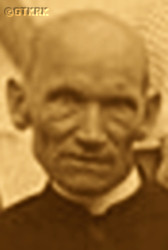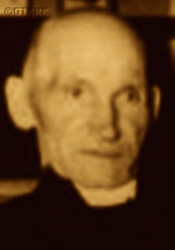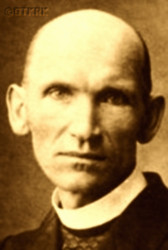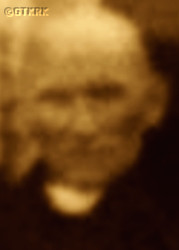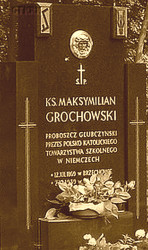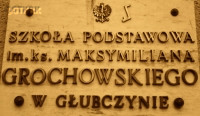Roman Catholic
St Sigismund parish
05-507 Słomczyn
85 Wiślana Str.
Konstancin deanery
Warsaw archdiocese, Poland
full list:
displayClick to display full list

searchClick to search full list by categories
wyświetlKliknij by wyświetlić pełną listę po polsku

szukajKliknij by przeszukać listę wg kategorii po polsku

Martyrology of the clergy — Poland
XX century (1914 – 1989)
personal data
surname
GROCHOWSKI
forename(s)
Maximilian Theodore (pl. Maksymilian Teodor)
function
diocesan priest
creed
Latin (Roman Catholic) Church RCmore on
en.wikipedia.org
[access: 2014.09.21]
diocese / province
Territorial Prelature of Schneidemühlmore on
en.wikipedia.org
[access: 2013.07.06]
Culm (Chełmno) diocesemore on
pl.wikipedia.org
[access: 2012.11.23]
date and place
of death
07.11.1939

Tucznotoday: Tuczno gm., Wałcz pov., West Pomerania voiv., Poland
more on
en.wikipedia.org
[access: 2021.07.18]
details of death
In 1918, at the end of World War I, became a member of the clandestine Polish Citizens' Committee. Next acted in the People's Council in Złotów. After the abdication of the German Emperor William II Hohenzollern on 09.11.1918, after the armistice between the Allies and Germany signed on 11.11.1918 in the HQ wagon in Compiègne, the HQ of French Marshal Ferdinand Foch — which de facto meant the end of World War I; after transfer of the supreme authority over the Polish army to Brigadier Joseph Piłsudski as its commander‐in‐chief — which de facto meant the rebirth of the Polish state — member of People's Council in Złotów, established in response to the self‐disclosure and founding on 11.11.1918 in Poznań, in the Prussian/German part of partitioned Poland, of the Polish People's Council opting for Poland. Before the final decision on the nationality of his parish, made during the Versailles conference, patronized the campaign to collect signatures of parents demanding the introduction of education in the native language to schools.
By the decision of the Great Powers, however, his parish — together with Złotów — remained in Germany. Was an active member of the Association of Poles in Germany, founded in 1923.
After German invasion of Poland on 09.1939 (Russians invaded Poland 17 days later) and start of the World War II arrested by the Germans on 11.09.1939.
Jailed for a fortnight in Złotów prison and next in ZL Albatros transit camp in Piła.
After another few weeks seriously ill released.
Did not recover and died shortly after in the hospital.
alt. details of death
His name is on the list of KL Sachsenhausen concentration camp victims.
cause of death
exhaustion
perpetrators
Germans
sites and events
ZL AlbatrosClick to display the description, KL SachsenhausenClick to display the description, «Intelligenzaktion»Click to display the description, Ribbentrop‐MolotovClick to display the description, Pius XI's encyclicalsClick to display the description
date and place
of birth
12.12.1869

Borzechowotoday: Zblewo gm., Starogard Gdański pov., Pomerania voiv., Poland
more on
en.wikipedia.org
[access: 2024.03.19]
parents
GROCHOWSKI Theodore
🞲 ?, ? — 🕆 ?, ?

NIERZWICKA Agnes
🞲 ?, ? — 🕆 ?, ?
presbyter (holy orders)
ordination
25.03.1897

Pelplintoday: Pelplin gm., Tczew pov., Pomerania voiv., Poland
more on
en.wikipedia.org
[access: 2021.05.06]
St Barbara RC chapelmore on
pl.wikipedia.org
[access: 2021.12.19] (in Theological Seminary)
positions held
1908 – 1939
parish priest — Głubczyntoday: Krajenka gm., Złotów pov., Greater Poland voiv., Poland
more on
en.wikipedia.org
[access: 2022.07.16] ⋄ St John the Baptist RC parish
from 1923
membership — Union of Poles in Germany ZPwN — president of the entire Association (from 1939), president of Association's Złotów chapter (1923‐1939); organizer of trips for Polish youth to Polish gymnasiums in Germany, trips for children and youth to Poland, collaborator and author of articles in the Polish press in Germany
1906 – 1907
administrator — Lutowotoday: Sępólno Krajeńskie gm., Sępólno Krajeńskie pov., Kuyavia‐Pomerania voiv., Poland
more on
en.wikipedia.org
[access: 2021.09.02] ⋄ St Lawrence the Deacon and Martyr RC parish ⋄ Kamień Pomorskitoday: Kamień Krajeński, Kamień Krajeński gm., Sępólno Krajeńskie pov., Pomerania voiv., Poland
more on
en.wikipedia.org
[access: 2021.09.02] RC deanery
1906
administrator — Godziszewotoday: Skarszewy gm., Starogard Gdański pov., Pomerania voiv., Poland
more on
en.wikipedia.org
[access: 2021.09.02] ⋄ St John of Nepomuk the Martyr RC parish — acting („ad interim”)
1901 – 1906
vicar — Godziszewotoday: Skarszewy gm., Starogard Gdański pov., Pomerania voiv., Poland
more on
en.wikipedia.org
[access: 2021.09.02] ⋄ St John of Nepomuk the Martyr RC parish
1897 – 1901
vicar — Oksywietoday: district of Gdynia, Gdynia city pov., Pomerania voiv., Poland
more on
en.wikipedia.org
[access: 2021.09.02] ⋄ St Michael the Archangel RC parish
1897 – 1901
student — Pelplintoday: Pelplin gm., Tczew pov., Pomerania voiv., Poland
more on
en.wikipedia.org
[access: 2021.05.06] ⋄ philosophy and theology, Theological Seminary
sites and events
descriptions
ZL Albatros: German transit Germ. Zivilgefangenenlager (Eng. camp for civilians) in Piła, operational in 09‐12.1939, mainly for Polish teachers and religious, who were treated especially rough, before transporting them to KL Sachsenhausen concentration camp, and for Jews. Prisoners were forced to slave in German manufacturing plants and local farms. Altogether more than 500 Poles were held captive there. (more on: pl.wikipedia.orgClick to attempt to display webpage
[access: 2019.11.17])
KL Sachsenhausen: In Germ. Konzentrationslager (Eng. concentration camp) KL Sachsenhausen, set up in the former Olympic village in 07.1936, hundreds of Polish priests were held in 1940, before being transported to KL Dachau. Some of them perished in KL Sachsenhausen. Murderous medical experiments on prisoners were carried out in the camp. In 1942‐1944 c. 140 prisoners slaved at manufacturing false British pounds, passports, visas, stamps and other documents. Other prisoners also had to do slave work, for Heinkel aircraft manufacturer, AEG and Siemens among others. On average c. 50,000 prisoners were held at any time. Altogether more than 200,000 inmates were in jailed in KL Sachsenhausen and its branched, out of which tens of thousands perished. Prior to Russian arrival mass evacuation was ordered by the Germans and c. 80,000 prisoners were marched west in so‐called „death marches” to other camps, i.e. KL Mauthausen‐Gusen and KL Bergen‐Belsen. The camp got liberated on 22.04.1945. After end of armed hostilities Germans set up there secret camp for German prisoners and „suspicious” Russian soldiers. (more on: en.wikipedia.orgClick to attempt to display webpage
[access: 2018.11.18])
«Intelligenzaktion»: German: «Intelligenzaktion» (English: „Intelligence Action”) — a German program of extermination of the Polish elite, mainly the intelligentsia and leadership layers, carried out from the beginning of the occupation in w 09.1939 to 04.1940, mainly in territories directly annexed to Germany, but also in the so‐called Germ. Generalgouvernement (Eng. General Governorate), where it was called «AB‐aktion». In the first phase, immediately after the beginning of the German occupation, during military operations carried out by the Germ. Wehrmacht (Eng. Armed Forces) and the genocidal units of the Germ. Einsatzgruppen (Eng. Operational Groups) of the Germ. Sicherheitspolizei (Eng. Security Police), i.e. SiPo, and Germ. Sicherheitsdienst des Reichsführers SS (Eng. Security Service of the Reichsführer SS), i.e. SD, organized by the Germ. Reichssicherheitshauptamt (Eng. Reich Main Security Office), i.e. RSHA, which followed the troops, carried out under the Germ. Unternehmen „Tannenberg” (Eng. Operation „Tannenberg”) — based on the so‐called Germ. Sonderfahndungsliste (Eng. Special Wanted Lists), i.e. proscription lists of Poles considered particularly dangerous to the Third Reich, prepared by the Zentralstelle II/P (Polen) unit of the German RSHA. Later, implemented by the German civilian occupation authorities and the genocidal unit of the Germ. Volksdeutscher Selbstschutz (Eng. Ethnic Germans Self‐Defense), whose members were Germ. Volksdeutsche (Eng. Ethnic Germans), i.e. representatives of the German minority in Poland. According to various sources, these lists, at the beginning of 09.1939, could have contained the details of 61,000—88,000 „dangerous” Poles — although these figures cannot be confirmed. In total, during this genocide, c. 50,000 teachers, Catholic priests, representatives of the landed gentry, freelancers, social and political activists, and retired military personnel were systematically and methodically murdered. Another 50,000 were sent to concentration camps, where only a negligible percentage survived. (more on: en.wikipedia.orgClick to attempt to display webpage
[access: 2014.10.04])
Ribbentrop‐Molotov: Genocidal Russian‐German alliance pact between Russian leader Joseph Stalin and German leader Adolf Hitler signed on 23.08.1939 in Moscow by respective foreign ministers, Mr. Vyacheslav Molotov for Russia and Joachim von Ribbentrop for Germany. The pact sanctioned and was the direct cause of joint Russian and German invasion of Poland and the outbreak of the World War II in 09.1939. In a political sense, the pact was an attempt to restore the status quo ante before 1914, with one exception, namely the „commercial” exchange of the so‐called „Kingdom of Poland”, which in 1914 was part of the Russian Empire, fore Eastern Galicia (today's western Ukraine), in 1914 belonging to the Austro‐Hungarian Empire. Galicia, including Lviv, was to be taken over by the Russians, the „Kingdom of Poland” — under the name of the General Governorate — Germany. The resultant „war was one of the greatest calamities and dramas of humanity in history, for two atheistic and anti‐Christian ideologies — national and international socialism — rejected God and His fifth Decalogue commandment: Thou shall not kill!” (Abp Stanislav Gądecki, 01.09.2019). The decisions taken — backed up by the betrayal of the formal allies of Poland, France and Germany, which on 12.09.1939, at a joint conference in Abbeville, decided not to provide aid to attacked Poland and not to take military action against Germany (a clear breach of treaty obligations with Poland) — were on 28.09.1939 slightly altered and made more precise when a treaty on „German‐Russian boundaries and friendship” was agreed by the same murderous signatories. One of its findings was establishment of spheres of influence in Central and Eastern Europe and in consequence IV partition of Poland. In one of its secret annexes agreed, that: „the Signatories will not tolerate on its respective territories any Polish propaganda that affects the territory of the other Side. On their respective territories they will suppress all such propaganda and inform each other of the measures taken to accomplish it”. The agreements resulted in a series of meeting between two genocidal organization representing both sides — German Gestapo and Russian NKVD when coordination of efforts to exterminate Polish intelligentsia and Polish leading classes (in Germany called «Intelligenzaktion», in Russia took the form of Katyń massacres) where discussed. Resulted in deaths of hundreds of thousands of Polish intelligentsia, including thousands of priests presented here, and tens of millions of ordinary people,. The results of this Russian‐German pact lasted till 1989 and are still in evidence even today. (more on: en.wikipedia.orgClick to attempt to display webpage
[access: 2015.09.30])
Pius XI's encyclicals: Facing the creation of two totalitarian systems in Europe, which seemed to compete with each other, though there were more similarities than contradictions between them, Pope Pius XI issued in 03.1937 (within 5 days) two encyclicals. In the „Mit brennender Sorge” (Eng. „With Burning Concern”) published on 14.03.1938, condemned the national socialism prevailing in Germany. The Pope wrote: „Whoever, following the old Germanic‐pre‐Christian beliefs, puts various impersonal fate in the place of a personal God, denies the wisdom of God and Providence […], whoever exalts earthly values: race or nation, or state, or state system, representatives of state power or other fundamental values of human society, […] and makes them the highest standard of all values, including religious ones, and idolizes them, this one […] is far from true faith in God and from a worldview corresponding to such faith”. On 19.03.1937, published „Divini Redemptoris” (Eng. „Divine Redeemer”), in which criticized Russian communism, dialectical materialism and the class struggle theory. The Pope wrote: „Communism deprives man of freedom, and therefore the spiritual basis of all life norms. It deprives the human person of all his dignity and any moral support with which he could resist the onslaught of blind passions […] This is the new gospel that Bolshevik and godless communism preaches as a message of salvation and redemption of humanity”… Pius XI demanded that the established human law be subjected to the natural law of God , recommended the implementation of the ideal of a Christian state and society, and called on Catholics to resist. Two years later, National Socialist Germany and Communist Russia came together and started World War II. (more on: www.vatican.vaClick to attempt to display webpage
[access: 2023.05.28], www.vatican.vaClick to attempt to display webpage
[access: 2023.05.28])
sources
personal:
pl.wikipedia.orgClick to attempt to display webpage
[access: 2013.05.19], www.pspwglubczynie.republika.plClick to attempt to display webpage
[access: 2013.12.04], mpn.poznan.uw.gov.plClick to attempt to display webpage
[access: 2013.05.19]
bibliographical:
„Biographical dictionary of priests of the Chełmno diocese ordained in the years 1821‐1920”, Henry Mross, Pelplin, 1995
original images:
commons.wikimedia.orgClick to attempt to display webpage
[access: 2018.02.15], szkolapodstawowawglubczynie.edupage.orgClick to attempt to display webpage
[access: 2018.02.15], www.bohaterowiekrajny.krakow.plClick to attempt to display webpage
[access: 2018.02.15], www.bohaterowiekrajny.krakow.plClick to attempt to display webpage
[access: 2018.02.15], fotopolska.euClick to attempt to display webpage
[access: 2014.01.06], www.bohaterowiekrajny.krakow.plClick to attempt to display webpage
[access: 2018.02.15]
LETTER to CUSTODIAN/ADMINISTRATOR
If you have an Email client on your communicator/computer — such as Mozilla Thunderbird, Windows Mail or Microsoft Outlook, described at WikipediaPatrz:
en.wikipedia.org, among others — try the link below, please:
LETTER to CUSTODIAN/ADMINISTRATORClick and try to call your own Email client
If however you do not run such a client or the above link is not active please send an email to the Custodian/Administrator using your account — in your customary email/correspondence engine — at the following address:

giving the following as the subject:
MARTYROLOGY: GROCHOWSKI Maximilian Theodore
To return to the biography press below:
 Click to return to biography
Click to return to biography








